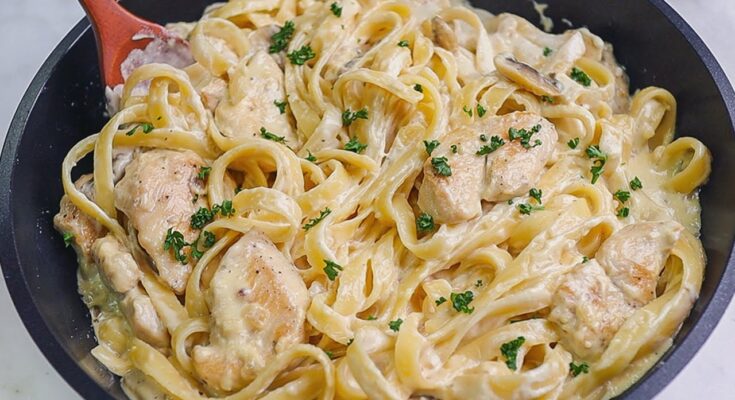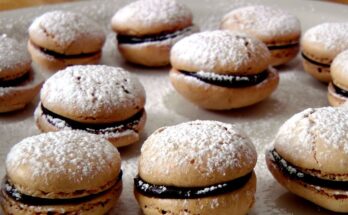Fettucine Alfredo Recipe: There’s something magical about a bowl of rich, creamy Fettucine Alfredo. It’s the kind of comfort food that hugs your soul and fills your belly with warmth. Whether you’re looking to impress guests at dinner or just treat yourself to something indulgent, this Italian-American classic never disappoints.
A Brief History of Alfredo
The story of Alfredo sauce begins in Rome in the early 20th century. It was first created by Alfredo di Lelio, who whipped up this creamy dish to help his wife regain her strength after childbirth. Word spread fast, and soon celebrities like Mary Pickford and Douglas Fairbanks brought the dish back to America, where it quickly gained popularity. Today, Alfredo has evolved—especially in the U.S.—with heavier cream-based variations that are richer and more decadent than the original.
Why Fettucine Works Best with Alfredo Sauce
Not all pasta shapes are created equal. Fettucine, with its flat, thick strands, is the ideal partner for Alfredo sauce. It holds the creamy coating well and delivers the perfect bite every time. Unlike spaghetti or penne, fettucine has just the right surface area and texture to soak up all the velvety goodness without turning soggy or limp.
Ingredients You’ll Need
Getting your ingredients right is half the battle. Alfredo is deceptively simple—just a few key components—but each one plays a vital role in the final flavor and texture.
Core Ingredients for Alfredo Sauce
Here’s what you’ll need for a traditional version:
- Fettucine pasta – 12 oz (preferably fresh, but dried works too)
- Butter – ½ cup (unsalted)
- Heavy cream – 1 cup
- Garlic – 2 cloves (minced)
- Parmesan cheese – 1 cup (freshly grated)
- Salt and black pepper – to taste
- Nutmeg (optional) – a pinch for added warmth
Each ingredient contributes to the signature taste: the butter and cream form the base, garlic adds a savory kick, and Parmesan brings depth and saltiness. Avoid pre-grated cheese—it doesn’t melt as smoothly and can ruin the texture of your sauce.
Optional Add-ins for Enhanced Flavor
Want to jazz things up? These ingredients are totally optional but add an extra dimension:
- Cooked chicken breast – sliced thin
- Shrimp – deveined and sautéed
- Mushrooms – sautéed until golden brown
- Spinach or kale – for a touch of green
- Crushed red pepper flakes – for a spicy kick
These additions allow you to personalize your Alfredo while keeping the base recipe classic and comforting.
Kitchen Tools Required
You don’t need a Michelin-star kitchen to make this dish. Here’s a checklist of what you’ll want to have on hand:
- Large pot (for boiling pasta)
- Deep skillet or saucepan (for the sauce)
- Colander (to drain pasta)
- Wooden spoon or spatula (for stirring)
- Cheese grater (for fresh Parmesan)
- Measuring cups and spoons
Having the right tools will save you time and hassle, especially when you need to multitask with boiling pasta and preparing sauce simultaneously.
Preparation Tips Before Cooking
Before you even turn on the stove, a bit of prep work will make the entire process smoother and less stressful.
Choosing the Right Pasta
Yes, fettucine is the star of this show, but not all pasta is created equal. If you can find fresh fettucine at a local market or Italian deli, grab it—it cooks faster and has a superior texture. Otherwise, opt for a high-quality dried version. Always read the cooking time on the package and aim for al dente—it should have a slight bite.
Prepping Ingredients in Advance
Chop, measure, and grate everything before you begin cooking. Here’s a handy pre-cooking checklist:
- Mince the garlic
- Grate the Parmesan
- Measure out cream and butter
- Rinse and dry any add-ins (like spinach or mushrooms)
Doing all this upfront keeps the process smooth and avoids any frantic last-minute chopping while your sauce is already bubbling.
Step-by-Step Instructions to Make Fettucine Alfredo
Let’s break it down. Making Fettucine Alfredo is surprisingly easy once you’ve got your ingredients and tools lined up. Follow these steps closely for a creamy, restaurant-style result at home.
Step 1: Boil the Fettucine to Perfection
Start by bringing a large pot of salted water to a rolling boil. Adding salt is essential—it’s your only chance to season the pasta from the inside. Use about 1 tablespoon of salt per 4 quarts of water.
Drop in the fettucine and give it a good stir to prevent sticking. Cook according to the package instructions for al dente, which means the pasta should still have a slight chew. This usually takes around 8–10 minutes for dried fettucine and about 2–4 minutes for fresh.
Don’t forget to reserve about a cup of pasta water before draining. This starchy water is liquid gold—it helps bind the sauce to the pasta and gives it that silky finish.
Step 2: Prepare the Creamy Alfredo Sauce
While your pasta cooks, it’s time to create the soul of the dish—the Alfredo sauce.
In a deep skillet over medium heat, melt the butter gently. Once it’s melted, toss in the minced garlic and sauté for about 30 seconds. You want it fragrant, not burnt.
Next, pour in the heavy cream and stir continuously. Let it simmer gently—not boil—for about 4–5 minutes. This step is all about thickening the cream and infusing it with that garlicky butter flavor.
Now, lower the heat and gradually sprinkle in the grated Parmesan cheese while stirring constantly. This is the magic moment—the cheese will melt into the cream, transforming it into a luscious, cheesy sauce. Add a pinch of nutmeg, salt, and freshly cracked pepper. Taste and adjust seasoning as needed.
Step 3: Combine Pasta and Sauce
Once your fettucine is perfectly cooked, drain it (don’t rinse it!) and immediately toss it into the Alfredo sauce. Use tongs to gently fold the pasta into the sauce, ensuring every strand is coated in creamy goodness.
If the sauce seems too thick, slowly add some reserved pasta water, a tablespoon at a time, until it reaches your desired consistency. The starch in the pasta water also helps the sauce cling beautifully to the noodles.
Step 4: Garnish and Serve
Plate the Alfredo pasta while it’s hot and steamy. For a finishing touch, add extra grated Parmesan, a twist of black pepper, and maybe a sprinkle of fresh chopped parsley or basil.
Serve immediately, as Alfredo tends to thicken as it cools. Want to elevate it even more? Add a few slices of grilled chicken, sautéed shrimp, or roasted veggies on top.
Pro Tips for the Perfect Alfredo
Mastering Alfredo isn’t just about the recipe—it’s about the little tricks that take it from good to unforgettable.
Avoiding Common Mistakes
- Don’t overheat the cream or cheese – High heat can make the sauce separate or become gritty.
- Say no to pre-shredded cheese – It often contains anti-caking agents that prevent smooth melting.
- Avoid overcooking pasta – Mushy pasta won’t hold the sauce well and ruins the texture.
- Don’t rush the sauce – Give the cream time to thicken naturally and let the cheese melt slowly.
Making It Creamier Without Curdling
To get that ultra-creamy texture:
- Use room temperature cheese and cream—they blend better.
- Always melt cheese on low heat.
- Stir gently but consistently.
- Add pasta water gradually to balance thickness and smoothness.
Remember, Alfredo should coat your pasta like velvet, not sit like a heavy puddle on your plate.
Customization Ideas
Want to make your Fettucine Alfredo a little more you? There are endless ways to customize this dish and keep it fresh every time.
Adding Proteins – Chicken, Shrimp, or Tofu
- Grilled Chicken: Season chicken breasts with salt, pepper, and garlic powder. Grill or pan-fry, then slice thin and place over the pasta.
- Shrimp: Quickly sauté shrimp in butter, garlic, and lemon juice for a light seafood twist.
- Tofu: Press firm tofu, cube it, and pan-sear until golden. Season with Italian herbs for a vegetarian-friendly protein.
Going Vegetarian or Vegan
To make it vegetarian, just skip the meat and maybe throw in some hearty vegetables like broccoli, peas, or mushrooms.
For a vegan Alfredo:
- Swap butter for olive oil or vegan margarine.
- Use full-fat coconut milk or cashew cream instead of heavy cream.
- Nutritional yeast or vegan Parmesan can replace traditional cheese.
The result? Still creamy, flavorful, and totally satisfying.
Best Sides to Serve with Fettucine Alfredo
While Fettucine Alfredo is rich and satisfying on its own, pairing it with the right sides can turn a simple meal into an unforgettable feast. You’ll want to balance the creamy richness with freshness, crunch, or a touch of acidity.
Classic Garlic Bread
There’s no better match for Alfredo than garlic bread. The crisp edges, soft middle, and garlicky butter blend perfectly with the creamy pasta. Use a French baguette or Italian loaf, slice it thick, slather on a mixture of butter, minced garlic, parsley, and a pinch of salt, then bake until golden brown. It’s perfect for mopping up every drop of sauce.
Fresh Green Salad
A crisp green salad offers a light contrast to the heaviness of Alfredo. Go for mixed greens, cherry tomatoes, cucumbers, and red onions. Top it with a tangy vinaigrette—think lemon, balsamic, or red wine dressing—to cut through the richness of the pasta.
Roasted Vegetables
Roasted asparagus, zucchini, bell peppers, or Brussels sprouts add earthy flavor and texture to your plate. Just toss them in olive oil, salt, pepper, and roast until slightly charred and tender. Bonus points if you roast them with a touch of garlic or lemon zest for extra zing.
Soup Starters
Start with a light soup like minestrone, vegetable, or a clear broth to set the stage for your Alfredo main course. Avoid cream-based soups—they’ll compete with the richness of your main dish rather than complement it.
Sparkling Beverage Pairings
To drink? Go with sparkling water with lemon, a crisp white wine like Pinot Grigio, or even a refreshing mocktail with citrus notes. These help cleanse your palate between bites.
Combining Alfredo with the right sides turns dinner into a complete, well-rounded meal that hits every note—rich, fresh, crunchy, and refreshing.
Storage and Reheating Tips
Let’s face it—Alfredo is best fresh. But if you have leftovers (lucky you), here’s how to make sure they’re just as delicious the next day.
Storing Leftover Alfredo
Allow the pasta to cool completely before storing. Place it in an airtight container and refrigerate. It will keep for about 3 to 4 days.
To prevent the pasta from absorbing too much sauce and becoming dry, consider storing the sauce and pasta separately if you haven’t already mixed them. Otherwise, be sure to add a splash of milk or cream before reheating to revive the sauce.
Reheating Without Ruining the Sauce
The trick to reheating Alfredo is low and slow.
- Stovetop method: Place the pasta in a skillet over low heat. Add a little milk or cream and stir constantly until heated through. This helps restore the creamy consistency without breaking the sauce.
- Microwave method: Use a microwave-safe bowl. Add a tablespoon of milk or cream, cover loosely, and heat in 30-second intervals, stirring in between. This helps heat it evenly without turning it into a rubbery mess.
Avoid high heat and never reheat Alfredo in a dry pan—it will become oily and separated.
Freezing Alfredo? Technically, yes—but it’s not ideal. Cream-based sauces often separate when thawed, resulting in a grainy texture. If you must freeze it, store in individual portions and reheat gently with added cream.
FAQs About Fettuccine Alfredo Recipe
Q1: What is Fettuccine Alfredo made of?
Fettuccine Alfredo is typically made with fettuccine pasta, butter, heavy cream, and grated Parmesan cheese. Some recipes may also include garlic, parsley, or black pepper for extra flavor.
Q2: Can I make Fettuccine Alfredo without cream?
Yes, you can substitute heavy cream with milk and a bit of flour or cream cheese to achieve a creamy texture without using actual cream.
Q3: How do I keep Alfredo sauce from clumping?
To prevent clumps, stir continuously while cooking and make sure the cheese is finely grated and added gradually into the warm (not boiling) cream and butter mixture.
Q4: Can I add protein to Fettuccine Alfredo?
Absolutely! Popular protein options include grilled chicken, shrimp, or even salmon. Just cook them separately and toss them in with the pasta and sauce before serving.
Q5: Is Fettuccine Alfredo good for meal prep?
While best enjoyed fresh, you can prepare and store Fettuccine Alfredo in the fridge for 2–3 days. Reheat gently on the stovetop with a splash of milk or cream to revive the sauce.
Q6: What’s the best cheese for Fettuccine Alfredo?
Freshly grated Parmesan is the traditional and best choice. Avoid pre-shredded cheese, as it may not melt smoothly.
Q7: Can I make this recipe gluten-free?
Yes! Simply use gluten-free fettuccine pasta and ensure any thickeners or seasonings you add are certified gluten-free.
Conclusion
Fettucine Alfredo is more than just a pasta dish—it’s an experience. With its luxurious texture and bold, cheesy flavor, it’s comfort food at its finest. And now that you know the step-by-step process, the secret to silky sauce, and how to customize it like a pro, you can whip up a restaurant-quality meal in your own kitchen any night of the week.
Remember: great Alfredo comes from quality ingredients, gentle cooking, and a little love. Whether you keep it classic or add your personal spin, Fettucine Alfredo is sure to become a regular favorite in your recipe rotation.



